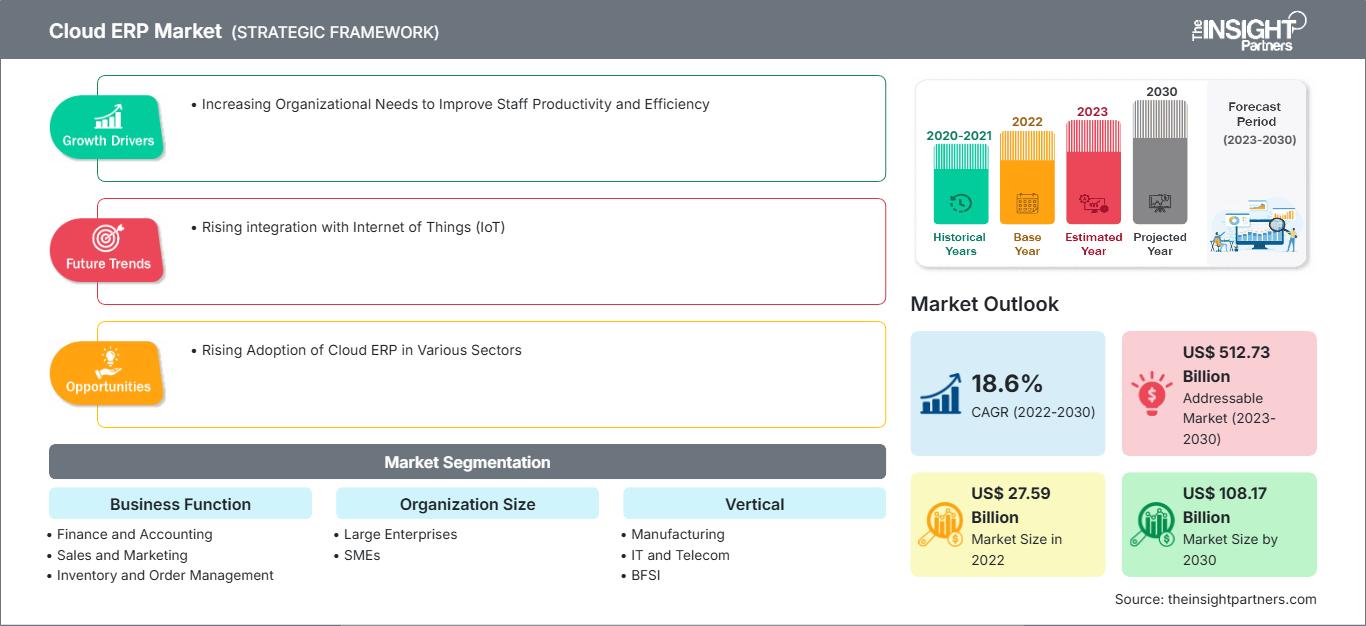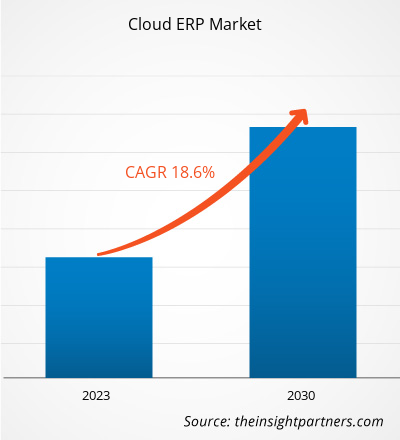클라우드 ERP 시장은 2022년 275억 9천만 달러에서 2030년에는 1,081억 7천만 달러로 성장할 것으로 예상되며, 2022년부터 2030년까지 연평균 성장률 18.6%를 기록할 것으로 예상됩니다. 사물 인터넷(IoT)과의 통합 증가는 시장의 주요 트렌드로 남을 것으로 보입니다.
클라우드 ERP 시장 분석
다양한 기업들이 새로운 클라우드 기반 ERP 소프트웨어를 출시하고 있습니다. 예를 들어, 10X ERP는 2023년 6월 중소 규모 산업 유통 기업의 요구를 충족하도록 특별히 설계된 클라우드 기반 ERP 소프트웨어 출시를 발표했습니다. 이 솔루션은 직관적이고 사용자 친화적이며 빠른 경험을 제공합니다. 핵심 기능은 판매 및 구매 주문 입력, 재고 관리, 고객 및 공급업체 관계 관리, 실시간 대시보드, 맞춤형 배송 통합 도구, QC 관리 도구, 그리고 실시간 데이터를 제공하는 강력하고 완벽하게 통합된 회계 시스템 등 광범위한 기능을 포함합니다. 시장 참여자들의 이러한 이니셔티브는 시장에서 클라우드 ERP의 성장을 촉진하고 있습니다. 또한 제조, IT 및 통신, BFSI, 의료, 소매 등 다양한 산업 분야에서 클라우드 ERP 소프트웨어 도입이 증가함에 따라 시장 성장이 가속화되고 있습니다. 더 나아가 소프트웨어의 기술 발전은 클라우드 ERP 시장의 성장을 더욱 가속화할 것으로 예상됩니다.
클라우드 ERP 시장 개요
클라우드 ERP는 인터넷을 통해 액세스할 수 있는 엔터프라이즈 자원 계획 소프트웨어로 알려져 있습니다. 공급업체의 클라우드 컴퓨팅 플랫폼에서 호스팅되는 클라우드 ERP는 일반적으로 서비스형 소프트웨어(SaaS ERP)로 제공됩니다. 클라우드 ERP 소프트웨어는 다양한 이점을 제공합니다. 클라우드 ERP 소프트웨어의 가장 큰 장점 중 하나는 거의 무한한 사용자 정의 기능입니다. 추가 솔루션, 개방형 API, 산업별 기능, 역할 기반 대시보드를 통해 기업은 강력한 의사 결정 도구, 탁월한 데이터 가시성, 그리고 성공을 위한 미래 지향적 플랫폼을 구현할 수 있습니다. 기업은 유통, 제조, 소매, 건설 등 특정 산업의 요구에 맞춰 설계된 원하는 에디션을 선택할 수 있습니다. 현장 팀과 사무팀은 예산과 기한 내에 여러 프로젝트를 완료하기 위해 협력하지만, 효율적인 정보가 부족할 경우 문제가 발생합니다. 건설 전문 ERP 소프트웨어는 재무, 작업 원가 계산, 재고, CRM, 급여, 프로젝트 관리 등 다양한 애플리케이션과 시스템을 통합하여 모든 팀원을 즉시 연결하고 비즈니스에 대한 완벽한 실시간 뷰를 제공합니다.
요구 사항에 맞게 이 보고서를 사용자 정의하십시오.
이 보고서의 일부, 국가 수준 분석, Excel 데이터 팩을 포함하여 모든 보고서에 대한 사용자 정의를 무료로 받을 수 있을 뿐만 아니라 스타트업 및 대학을 위한 훌륭한 제안 및 할인을 이용할 수 있습니다
클라우드 ERP 시장: 전략적 통찰력

-
이 보고서의 주요 주요 시장 동향을 확인하세요.이 무료 샘플에는 시장 동향부터 추정 및 예측에 이르기까지 데이터 분석이 포함됩니다.
CloudERP 시장 성장 동력 및 기회
시장 호황을 위한 직원 생산성 및 효율성 향상에 대한 조직의 요구 증가
기업들은 빠르게 변화하고 경쟁이 치열한 오늘날의 비즈니스 환경에서 생산성과 효율성을 높일 방법을 끊임없이 모색하고 있습니다. 클라우드 기반 전사적 자원 관리(ERP) 시스템은 비즈니스 성장, 협업 및 효율적인 운영을 지원하여 많은 주목을 받고 있습니다. 클라우드 ERP는 기존 온프레미스 시스템에 비해 다양한 이점을 제공합니다. 클라우드 기반 시스템은 인터넷에 연결된 곳이라면 어디에서나 액세스할 수 있습니다. 즉, 직원들은 중요한 비즈니스 협업 데이터를 검색하고 원격으로 작업을 수행할 수 있습니다. 예를 들어, 영업 담당자는 이동 중에도 실시간 재고 데이터에 액세스하여 적시에 고객과 소통할 수 있습니다. 클라우드 ERP는 실시간 데이터 업데이트 및 분석을 제공하여 정보에 기반한 의사 결정을 내리는 데 활용할 수 있습니다. 예를 들어, 관리자는 클라우드 ERP 시스템에서 얻은 데이터를 사용하여 재고 수준과 수요를 실시간으로 모니터링하여 사전 재고 확보 및 생산 일정 최적화를 실현할 수 있습니다. 클라우드 ERP에는 팀워크와 협업을 향상시키는 협업 도구가 포함되어 있습니다. 예를 들어, 클라우드 ERP 시스템은 원격 팀 간의 프로젝트 관리 및 협업을 용이하게 하여 프로젝트 워크플로를 간소화하고 오류를 줄여줍니다. 또한, 클라우드 ERP는 프로세스를 자동화하고 온프레미스 인프라의 필요성을 줄여 운영 비용을 절감할 수 있습니다.
다양한 산업 분야에서 클라우드 ERP 도입 증가
클라우드 ERP 시장은 지난 몇 년간 큰 폭으로 성장했으며, 이러한 성장의 주요 원동력 중 하나는 클라우드 ERP 시스템의 디지털화입니다. 첨단 기술과 효율적이고 간소화된 세무 프로세스에 대한 기업의 수요 증가로 인해 모든 세무 관련 활동을 더욱 간편하게 해주는 디지털 솔루션에 대한 수요가 급증하고 있습니다. 클라우드 ERP 시스템의 디지털화는 규모와 관계없이 모든 기업과 모든 사람에게 많은 이점을 제공합니다. 가장 큰 장점 중 하나는 세무 관련 모든 업무의 자동화입니다. 이를 통해 수작업을 줄이고 오류 발생 가능성을 최소화할 수 있습니다. 클라우드 ERP를 통해 데이터 입력, 세금 계산 및 보고를 자동화하여 정확성을 확보하고 세법을 준수할 수 있습니다.
클라우드 ERP 시장 보고서 세분화 분석
클라우드 ERP 시장 분석에 기여한 주요 부문은 비즈니스 기능, 조직 규모 및 산업입니다.
- 비즈니스 기능을 기준으로 시장은 재무 및 회계, 영업 및 마케팅, 재고 및 주문 관리, 인적 자원 관리, 기타로 세분화됩니다. 재고 및 주문 관리 부문은 2022년에 시장을 장악했습니다.
- 조직 규모를 기준으로 시장은 대기업과 중소기업으로 나뉩니다. 대기업 부문이 2022년에 시장을 장악했습니다.
- 산업을 기준으로 상업 기업 시장은 제조, IT 및 통신, BFSI, 의료, 소매, 정부, 항공우주 및 방위 등으로 나뉩니다. 2022년에는 제조 부문이 시장을 장악했습니다.
지역별 클라우드 ERP 시장 점유율 분석
클라우드 ERP 시장 보고서의 지리적 범위는 주로 북미, 아시아 태평양, 유럽, 중동 및 아프리카, 중남미의 5개 지역으로 나뉩니다.
2022년에는 북미가 시장을 장악했습니다. 기술 변화는 북미 경제에 상당한 영향을 미칩니다. 북미의 모든 선진국은 기술 혁신에 상당한 중점을 두고 있습니다. 미국 경제는 기술에 크게 의존합니다. 결과적으로 많은 주에서 혁신을 촉진하고 기업가에게 힘을 실어주기 위한 주요 계획에 착수했습니다. 가장 많이 언급된 기술은 사물 인터넷(IoT), 빅데이터 분석, 모빌리티, 인공지능(AI), 디지털 미디어, 생명 공학, 원격 의료, 클라우드 컴퓨팅입니다. 북미의 다양한 기업들이 새로운 클라우드 기반 소프트웨어를 구축하고 있습니다. 예를 들어, 2023년 4월, SAP SE는 Greater Austin Merchants Cooperative Association(GAMA)이 조직의 미래 경쟁력을 확보하고 비즈니스 혁신을 지원하는 퍼블릭 에디션인 SAP S/4HANA Cloud를 선택했다고 발표했습니다. SAP S/4HANA Cloud 퍼블릭 에디션을 통해 SAP는 중견 기업이 업계 모범 사례를 기반으로 클라우드 ERP의 검증된 이점을 활용할 수 있도록 지원하고 있습니다.
CloudERP
클라우드 ERP 시장 지역별 통찰력
The Insight Partners의 분석가들은 예측 기간 동안 클라우드 ERP 시장에 영향을 미치는 지역별 동향과 요인을 면밀히 분석했습니다. 이 섹션에서는 북미, 유럽, 아시아 태평양, 중동 및 아프리카, 중남미 지역의 클라우드 ERP 시장 세분화 및 지역별 분포도 살펴봅니다.
클라우드 ERP 시장 보고서 범위
| 보고서 속성 | 세부 |
|---|---|
| 시장 규모 2022 | US$ 27.59 Billion |
| 시장규모별 2030 | US$ 108.17 Billion |
| 글로벌 CAGR (2022 - 2030) | 18.6% |
| 이전 데이터 | 2020-2021 |
| 예측 기간 | 2023-2030 |
| 다루는 세그먼트 |
By 사업 기능
|
| 포함된 지역 및 국가 |
북미
|
| 시장 선도 기업 및 주요 회사 프로필 |
|
클라우드 ERP 시장 참여자 밀도: 비즈니스 역학에 미치는 영향 이해
클라우드 ERP 시장은 소비자 선호도 변화, 기술 발전, 그리고 제품의 이점에 대한 인식 제고 등의 요인으로 인한 최종 사용자 수요 증가에 힘입어 빠르게 성장하고 있습니다. 수요 증가에 따라 기업들은 제품 및 서비스 확장, 소비자 니즈 충족을 위한 혁신, 그리고 새로운 트렌드를 적극 활용하며 시장 성장을 더욱 가속화하고 있습니다.

- 을 얻으세요 클라우드 ERP 시장 주요 주요 플레이어 개요
클라우드 ERP 시장 뉴스 및 최근 동향
클라우드 ERP 시장은 1차 및 2차 조사 후 주요 기업 간행물, 협회 데이터, 데이터베이스 등 정성적 및 정량적 데이터를 수집하여 평가합니다. 클라우드 ERP 시장의 몇 가지 동향은 다음과 같습니다.
- SAP와 파트너사인 SGN Software Pvt Ltd는 중소 규모 기업을 위한 주력 클라우드 ERP 솔루션을 출시했습니다. (출처: SAP, 보도자료, 2024년 7월)
- 산업 중견 기업을 위한 ERP 소프트웨어 솔루션을 제공하는 유럽 기업 Forterro는 엔트리 레벨 클라우드 기반 ERP 솔루션인 Fortee의 영국 출시를 발표했습니다. Fortee는 중소기업 및 스타트업의 니즈를 충족하도록 특별히 설계되었으며, 15년간의 클라우드 ERP 경험을 바탕으로 합니다. (출처: Forterro, 보도자료, 2024년 5월)
클라우드 ERP 시장 보고서 범위 및 제공 내용
“클라우드 ERP 시장 규모 및 예측(2020~2030년)” 보고서는 다음 영역을 포괄하는 시장에 대한 자세한 분석을 제공합니다.
- 범위에 포함된 모든 주요 시장 부문에 대한 글로벌, 지역 및 국가 수준의 클라우드 ERP 시장 규모 및 예측
- 클라우드 ERP 시장 동향 및 추진 요인, 제약 및 주요 기회와 같은 시장 역학
- 자세한 PEST/포터의 5가지 힘 및 SWOT 분석
- 주요 시장 동향, 글로벌 및 지역 프레임워크, 주요 업체, 규정 및 최근 시장 개발을 포괄하는 클라우드 ERP 시장 분석
- 시장 집중도, 히트맵 분석, 주요 업체 및 초전도 시장의 최근 개발을 포괄하는 산업 환경 및 경쟁 분석
- 자세한 회사 프로필
- 과거 분석(2년), 기준 연도, CAGR을 포함한 예측(7년)
- PEST 및 SWOT 분석
- 시장 규모 가치/거래량 - 글로벌, 지역, 국가
- 산업 및 경쟁 환경
- Excel 데이터세트
최근 보고서
사용 후기
구매 이유
- 정보에 기반한 의사 결정
- 시장 역학 이해
- 경쟁 분석
- 고객 인사이트
- 시장 예측
- 위험 완화
- 전략 기획
- 투자 타당성 분석
- 신흥 시장 파악
- 마케팅 전략 강화
- 운영 효율성 향상
- 규제 동향에 발맞춰 대응






















 무료 샘플 받기 - 클라우드 ERP 시장
무료 샘플 받기 - 클라우드 ERP 시장